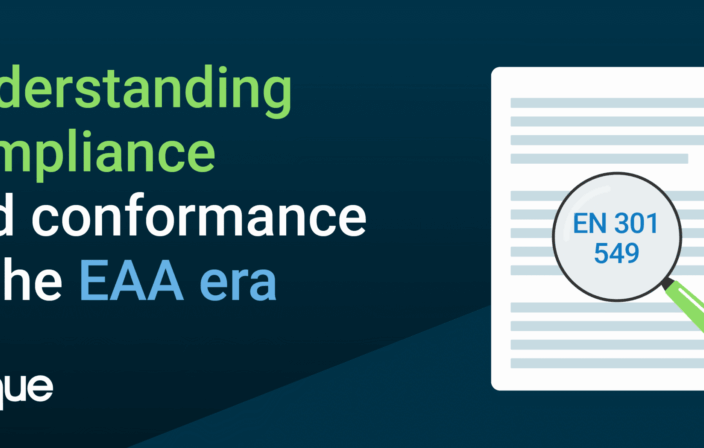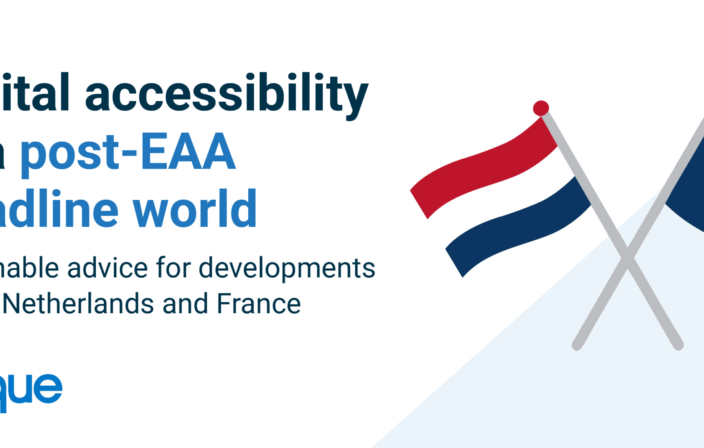In the past year, the European Union has made great strides in passing legislation that improves accessibility for people with disabilities in the EU (approximately 80 million people). The European Accessibility Act (EAA) and the European Web Accessibility Directive are two pieces of legislation that will have an immediate and ongoing impact in the next few years.
Below, this post will review each piece of legislation, discuss who it applies to and major deadlines, and explain the differences and similarities between the European Accessibility Act and the European Web Accessibility Directive.
European Accessibility Act (EAA)
On June 7th, 2019 the European Union formally adopted the European Accessibility Act. The main goal of the European Accessibility Act is to create a common set of accessibility guidelines for EU member states and fix the diverging accessibility requirements.
While many EU Member States already have some form of accessibility legislation, there is no EU law on accessibility. The EU member states have two years to translate the act into their national laws and four years to apply them.
The European Accessibility Act (EAA) also applies to any business’s product or service that is sold or in use within the Eurozone, not just EU member state businesses.
Despite the enforcement date being six years away, we strongly encourage organizations to get ahead of the curve and start implementing accessibility into their product and service design stages now.
The EAA aims to improve the functioning of the internal market for accessible products and services. This act covers products and services that are the most important for people with disabilities and the increasing aging population, such as:
- Computers and operating systems
- ATMs, ticketing and check-in machines
- Smartphones
- TV equipment related to digital television services
- Telephone services and related equipment
- Access to audio-visual media services such as television broadcast and related consumer equipment
- Services related to air, bus, rail, and waterborne passenger transport
- Banking services
- E-books
- Online shopping websites and mobile applications
The accessibility requirements apply unless the requirements would change the very nature of the product/service or if the requirements would impose an undue financial burden. The undue burden exemption would largely apply to micro-organizations with less than 20 employees.
EU Web Accessibility Directive
Who must conform to the EU Web Accessibility Directive?
On October 26, 2016, the EU Parliament and the Council of the European Union passed the EU Web Accessibility Directive. The Directive aims to create a more standardized and harmonized framework around the accessibility of websites and mobile applications of public sector bodies. Specifically, this directive applies to:
- State, regional or local authorities
- Bodies governed by public law
- Associations formed by one (or more) such authorities or one (or more) such bodies governed by public law if those associations are established for the specific purpose of meeting needs in the general interest, not having an industrial or commercial character
It is important to note that although the EU Web Accessibility Directive applies to public-sector websites and apps, it will have an impact on private organizations as well. Organizations that regularly do business with or provide products/services that impact public-facing government sites and apps may need to comply.
There are exceptions to the coverage; public service broadcasters or non-governmental organizations that do not provide services that are important to the public or specifically for people with disabilities are excluded from this Directive.
Upcoming Deadlines
On December 23, 2018 member states were required to have the following:
- An accessibility statement
- An accessible feedback mechanism
- An enforcement procedure outlining penalties and process for non-compliance
- Standards for monitoring methodology and reporting
- Uniform technical specifications for mobile apps
Below are the following upcoming deadlines that member states are required to adhere to:
| 2019 Deadline | 2020 Deadline | 2021 Deadline |
|---|---|---|
| On September 23, 2019, all new public sector websites and apps were required to conform to the directive | By September 23, 2020, all new and existing public website must conform to the directive | By June 23, 2021, all new and existing mobile apps must conform to the directive |
Harmonized Accessibility Standards
EN 301 549
The Directive itself references the four principles of accessibility and sets the minimum standard for accessibility equivalent to WCAG 2.1 AA. The method of enforcement for this directive is called EN 301 459.
EN 301 549 is an accessibility standard that covers all Information and Communication Technology (ICT). This includes almost every digital product you can think of: cell phones, printers, ATMs, electronic documents, software, web content and more.
EN 301 549 points to the Web Content Accessibility Guidelines (WCAG) version 2.1 AA as a minimum level of compliance.
WAI-Tools and ACT Rules
The EU Directive notes the shortcomings of EN 301 549, especially for mobile applications. To address these shortcomings, the European Commission Rolling Plan on ICT Standardization calls for updating EN 301 549 as well as developing a methodology/framework for testing requirements.
The Web Accessibility Initiative (WAI)-Tools of the W3C, is an international effort currently being developed to fill the need for a standardized methodology for testing. The backbone of the WAI-Tools project is a common set of open test rules that provide an authoritative interpretation of the Web Content Accessibility Guidelines (WCAG) developed by the W3C.
WAI-Tools will accelerate the development of the W3C repository of authoritative test rules, to better address the urgent demand created by the EU Directive on web accessibility.
Deque is proud to be partnering with the W3C in WAI-Tools and is currently helping to develop and write ACT rules.
Ongoing Requirements for Member State Compliance
- An Accessibility Statement – outlining and explaining inaccessible elements and guidelines for users may provide feedback
- Monitoring – periodic monitoring and sampling of web pages, arrangements of automatic, manual and usability test.
- Reporting – starting 23rd of December 2021, and every three years thereafter Member State must report on their compliance in an accessible report format that will be published to the public.
Similarities and Differences Between the EAA and the Web Accessibility Directive
While both pieces of legislation make great strides for accessibility in the EU, there are many similarities and differences which are important to note. Similarities between the two pieces of legislation include:
- The law’s compliance will be monitored by market surveillance authorities
- There are opportunities for the consumer to appeal against lack of accessibility
- Member States may demand fines for those who do not comply with the law
- Member States should report the status to the Commission
- Both pieces of legislation were created in an attempt to harmonize accessibility standards across the Member States
- Difference between the two pieces of legislation include:
The EAA applies to hardware, software, web (only for e-commerce, transportation, and banking verticals), and mobile (only for e-commerce, transportation, and banking verticals) and the Web Accessibility Directive applies to web and mobile accessibility for government agencies.
- The EAA applies to both public and private businesses, while the Web Accessibility Directive applies to government-funded agencies and their third-party vendors.
- The Web Accessibility Directive is actively being enforced, while the EAA won’t be enforced until 2025.
- Both pieces of legislation point to WCAG for web accessibility requirements, although the Web Accessibility Directive references WCAG 2.1 directly.
Immediate Steps Your Organization Can Take to Prevent an Accessibility Lawsuit or Complaint
- Provide an accessibility statement on your website – The best method to prevent legal action against being inaccessible is having an accessibility statement that outlines your organization’s ongoing commitment to accessibility.
- Audit your website – Most accessibility projects begin and end with an audit. They assess the current state of your site or application’s accessibility.
- Start simple with free, open-source automated testing tools, such as axe. Such tools can catch between 30-50% of accessibility issues. Axe is also available as a browser extension for Chrome and Firefox, and there are axe tools for testing Android applications and iOS (coming soon).




